|
|
Some Chess Questions Answered
From time to time people send me chess related questions. Here are a few with some answers. If you have a question you would like me to answer on this page then feel free to send it to me at chyss[at]yahoo[dot]co[dot]uk. I'll probably get around to trying to answer it sooner or later. Alternatively leave your question in my guestbook here.
Question: "If the king is in check, and the piece that is holding it in check is directly adjacent from the king can the king take it?" - Clint
Answer:
Yes, but only if the attacked king would not be moving into check by capturing the attacking piece. Thus, for example, if the white king is on its starting square (e1) and there is a black rook directly in front of it (e2), then, as long as no (black) piece is defending the rook on e2 the white king can take the black rook.
Question: "Tell me some checkmate moves" - Anonymous.
Answer:
I am always pleased when someone sends me such a well thought out question.
I am happy to offer an equally well thought out answer:
1. e4 e5, 2. Bc4 Nc6, 3. Qh5 Nf6, 4. Qxf7 checkmate.
1. g4 e5, 2. f3 Qh4 checkmate.
1. e4 b6, 2. Nf3 Bb7, 3. Bc4 Bxe4, 4. Ng5 Bb7, 5. Bxf7 checkmate.
Question: "When I read the moves people make how can I tell whether it was white or black who made the move?"- Annonymous.
Answer:
You will always see a move number (e.g. 1), which is usually followed by a full stop. The next thing you will see is a letter representing the piece in question. Thus N stands for knight, K for king, and B for bishop etc. If there is no capital letter it means that the piece in question is a pawn. The next thing you will see is the destination square of the piece. Moves come in pairs after each move number. The first is white's, the second black's. Thus " 1. Nc3 Nf6, " means " white's first move is knight to c3 and black's first move is knight to f6 ". Equally, you might see " 3. d4 ed, " which means "white's third move is pawn to d4 and black's third move is pawn on e5 takes pawn on d4 ". For an explanation of the lettering and numbering of squares see my page at How to play chess
Question: "Is the Fried Liver attack for black or white?" - Annonymous
Answer:
The Fried liver attack is an opening for white. The main line goes 1. e4 e5, 2. Nf3 Nc6, 3. Bc4 Nf6, 4. Ng5 d5, 5. ed NxP?!, 6. Nxf7!? KxN, 7. Qf3+ Ke6, 8. Nc3 Nb4. The move 6. d4! is an improvement.
A few questions from Terry.
Question: "How would you suggest that someone who wants to play the Caro Kann improve their performance against more experienced players?"
Answer:
I suggest an in depth study of Grandmaster games annotated by Grandmasters. If you intend to stick with the opening then it's probably worth getting a good book on it as this will provide you with a good selection of well annotated high level games.
In one off games it might be worth trying a couple of slightly unusual lines (for surprise value) such as
1. e4 c6, 2. d4 d5, 3. Nc3 g6!?
or the somewhat more surprising but less sound
1. e4 c6, 2. d4 d5, 3. Nc3 ed, 4. Nxe4 g6?! 5. Nf3 Bg7, 6. Bc4 Nf6!
and finally the Arkell favourite
1. e4 c6, 2. d4 d5, 3. e5 c5!?
Question: "What should I do if people don't play a kingside fianchetto against me when I play the Tarrasch defence after 1. d4 d5, 2. c4 e6, 3. Nc3 c5?"
Answer:
Smile to yourself and be happy that they have not played the best line!
Just develop actively making use of c4, e4 and the open or half open
c and e files with your rooks.
Question: "Also, what do I do if if they don't put their knight on d2 after 1. e4 e6, 2. d4 d5,?"
Answer:
Note the difference between the Tarrasch defence to the Queens Gambit Declined
(1. d4 d5, 2. c4 e6, 3. Nc3 c5) and the Tarrasch variation of the French
(1. e4 e6, 2. d4 d5, 3. Nd2). These are two different openings.
You have to be prepared for 4 main lines when playing the French
A) 1. e4 e6, 2. d4 d5, 3. e5
B) 1. e4 e6, 2. d4 d5, 3. Nc3
C) 1. e4 e6, 2. d4 d5, 3. Nd2
D) 1. e4 e6, 2. d4 d5, 3. ed
I think that the 3. ... Be7 line is quite interesting against B) and C) and that the aggressive 3. ... ed 4. Bd3 c5!? is a good try against D)
The main line of A) (3. ... c5, 4. c3 Qb6 etc.) shouldn't cause black any headaches.
Again, if you intend to stick with the opening it is probably worth getting hold of a book on it. Watson's book on the French is superb (and now in its third edition).
Question: "I've got this book by Eric Schiller..."
Answer:
Never mind!
Question: "What middlegame and endgame books do you recommend?"
Answer:
I was impressed by two books by Speelman called "Endgame Preparation" and "Analysing the Endgame". Averbach's "Chess Endgames: Essential Knowledge" is good too, and more systematic, though less advanced. Max Euwe's "Judgement and Planning in Chess" is an excellent middlegame book, as is Nimzowich's "My System". For more advanced readers I highly recommend Watson's "Secrets of Modern Chess Strategy".
Question: "What is a zwischenzug?"
Answer:
Literally an "in-between move". A move in a tactical sequence is called a zwischenzug when it does not relate directly to the tactical motif in operation.
Thanks Terry, for some very fine questions.
Question:"Can a king and a rook only, put a king in mate? (No other pieces on board.)" - Joe
Answer:
Yes. As an example, consider the following position: (It's checkmate.)
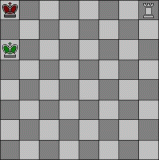
Some variations on this theme are possible. For example, the White king could be one square to the right (on b6) and it would still be checkmate. The white rook could be on the second, third, fourth, fifth, or sixth square from the right (g8, f8, e8, d8, or c8) and it would still be checkmate. If we keep the kings facing (with the black king on the 8th and last rank and the white king on the 6th rank) and the white rook on h8 (the far right corner) then the kings could be facing each other on the first, second, third, fourth, fifth, or sixth square from the left (a8 and a6, b8 and b6, c8 and c6, d8 and d6, e8 and e6, or f8 and f6) and it would still be checkmate.
I suppose the next question is how to force one of these positions. The key is to imagine your pieces creating 'areas of check' which the enemy king cannot move into. You must use these 'areas of check' to push the enemy king against the side of the board and then to squash him. Now take a look at the next diagrammed position.
It's white's move. First I'll try to write the moves verbally for those of you who don't read standard chess notation and then I'll give you the key lines in standard chess notation. If you read standard chess notation then skip down to "A)".
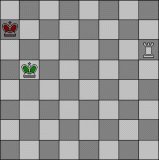
There are two equally good ways for white to play in this position. The first begins with White moving the rook one square towards the far side of the board. Black will have to move his king back against the edge of the board (notice that here he has two squares against the edge of the board to choose from). White will then move his king forward (towards the far side of the board) so that it is on the file (files are lines of squares up and down the board) to the right of the black king. Black will then move his king one step to the side. If the black king is now on the second or third square from the left of the board then white can play his rook to the far right hand corner and it will be checkmate. If the black king is now on the far left square of the board then white will move his king one square to the left. Black will have to move his king one square to the right, and then white can play his rook to the far right hand corner and it will be checkmate. The second way for white to play the position begins with him moving the rook so it is infront of his king and one square diagonally from the black king. Black will have to move his king to the far left hand corner of the board. White should then move his king diagonally forwards and to the right so that it is on the same diagonal as the black king with one square in between them. Black will have to move his king one square towards the near side of the board. White should then move his king one square forwards. Black will have to move his king back into the far left hand corner of the board and white can then move his rook one square to the left and it will be checkmate.
In standard chess notation all that means is:
A)1. Rh7+
A1)1. ... Ka8, 2. Kb6 Kb8, 3. Rh8++
A2)2. ... Kb8, 2. Kc6
A21) 2. ... Kc8, 3. Rh8++
A22) 2. ... Ka8, 3. Kb6 Kb8, 4. Rh8++
B)1. Rb6 Ka8, 2. Kc6 Ka7, 3. Kc7 Ka8, 4. Ra6++
Now you can see why someone invented standard chess notation!!!
The principle is the same wherever you are on the board. You push the enemy king back with your rook, hold him there with your king, and then push him back again with your rook. If you keep doing this then eventually the rook's move won't be a push, it will be a checkmate.
Question: "I would like you to explain en passent. I do not fully understand when and when you can not preform this move. Thanks." - Dude
Answer:
Ok. The en passent rule is not very easy to explain. Here's what I say on my "how to play chess" page:
En passent: If a pawn is on its fifth rank (ranks are rows of squares across the board) and an enemy pawn moves two squares forward to either of the adjacent squares to the pawn then the pawn on its fifth rank may (on its very next move, but not after its very next move) capture this enemy pawn as if the enemy pawn had only moved one square.
Given that you asked the question I assume that you'd like a little more explanation so I'll use an example with some diagrams:
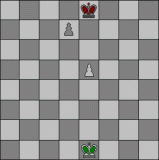
Here is the starting position for our example. As is customary with such diagrams white is playing up the board and black is playing down the board. However, in this position it is black to move.
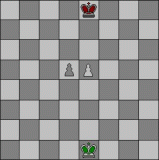
In this second diagram the black pawn has moved two spaces forward (in one move). (Not a particularly good move in this position. Ke7 was winning for black.)
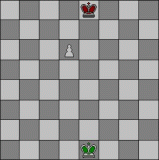
In this third diagram the white pawn has just captured the black pawn as if it had only moved one square forwards. This is en passent.
En passent is only possible when ALL of the following conditions are met.
1. The enemy pawn has moved two squares forward (in one move).
2. Your pawn now stands on one of the two squares next to the enemy pawn.
3. It is the very next move (i.e. the next ply) after the enemy pawn moved two squares forward (in one move).
Thus, if the enemy pawn has moved from d7 to d5 and you have a pawn on either e5 or c5 you may capture the enemy pawn on d5 on your very next turn as if the pawn had only moved one square by moving your pawn from either e5 or c5 to d6 and removing the enemy pawn.
('Obviously', the normal rules of chess apply to en passent captures, i.e., you cannot make such a capture if it would place you in check or if you are in check and the capture would not get you out of check etc.)
Question: "I am a beginner and have always wondered if there was some sort of trick or constant when starting out a chess game. And, I mean as far as moving your pawns. I seem to want to always try something different, but then I always end up mirroring each piece. Is this a good idea? Bad idea? Please give me some good tips on how to start out a winning chess match. Thanks for your time." - Nick.
Answer:
When you start a game of chess your objectives should be to develop your pieces and to control the centre. If you play moves which achieve these two objectives then you will not go very far wrong. Bobby Fischer argued that 1. e4 was the best move, and it is the move which scores best statistically. 1. e4 is a particularly good move to play for beginners because it exposes them to the kinds of open positions which will help them to improve their chess rapidly. If you are white I would advise you to play 1. e4. As black you need to tailor your response to the moves your opponent has played.
So, for example, if white plays 1. e4 then the best replies available are 1. ... e5, 1. ... e6, and 1. ... c5. There are other moves but they are arguably not quite so reliable. If white plays 1. d4 then the best replies available are 1. ... d5, and 1. ... Nf6. Again, there are other moves which are almost as good, but they are just a little bit less respectable. Mirroring for its own sake is not advisable. Sometimes mirroring works, but only coincidentally. Try not to play a move simply because it is, or is not, a mirroring move. Ignore this factor in your decision making process. For more information on openings, try my my repertoire, common openings, and tricks pages.